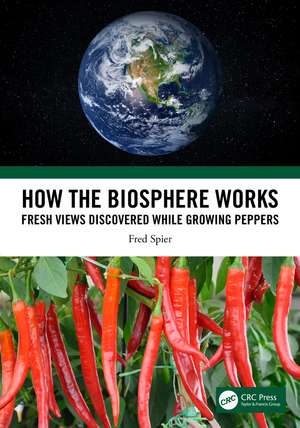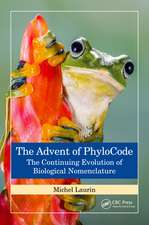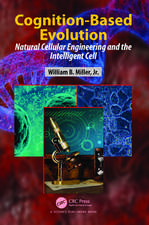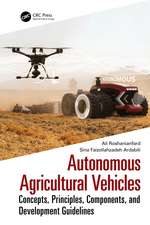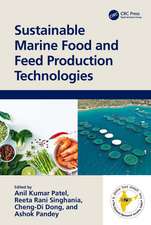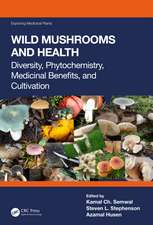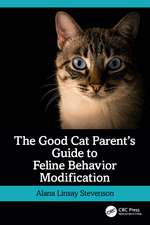How the Biosphere Works: Fresh Views Discovered While Growing Peppers
Autor Fred Spieren Limba Engleză Hardback – 6 mai 2022
Key Features
- Documents what the biosphere is, and what our position as humans within it is today.
- Describes how the biosphere has become the way it is.
- Summarizes the novel simple theoretical model proposed in the book, and thus, how the biosphere functions.
- Predicts what the possibilities and limitations are for future human action
- Emphasizes how simple but careful observations can lead to far-reaching theoretical implications.
| Toate formatele și edițiile | Preț | Express |
|---|---|---|
| Paperback (1) | 540.24 lei 6-8 săpt. | |
| CRC Press – 6 mai 2022 | 540.24 lei 6-8 săpt. | |
| Hardback (1) | 1276.34 lei 6-8 săpt. | |
| CRC Press – 6 mai 2022 | 1276.34 lei 6-8 săpt. |
Preț: 1276.34 lei
Preț vechi: 1556.51 lei
-18% Nou
Puncte Express: 1915
Preț estimativ în valută:
244.30€ • 265.46$ • 205.35£
244.30€ • 265.46$ • 205.35£
Carte tipărită la comandă
Livrare economică 21 aprilie-05 mai
Preluare comenzi: 021 569.72.76
Specificații
ISBN-13: 9781032230412
ISBN-10: 103223041X
Pagini: 274
Ilustrații: 1 Tables, black and white; 1 Line drawings, color; 1 Line drawings, black and white; 15 Halftones, color; 34 Halftones, black and white; 16 Illustrations, color; 35 Illustrations, black and white
Dimensiuni: 156 x 234 x 18 mm
Greutate: 0.56 kg
Ediția:1
Editura: CRC Press
Colecția CRC Press
ISBN-10: 103223041X
Pagini: 274
Ilustrații: 1 Tables, black and white; 1 Line drawings, color; 1 Line drawings, black and white; 15 Halftones, color; 34 Halftones, black and white; 16 Illustrations, color; 35 Illustrations, black and white
Dimensiuni: 156 x 234 x 18 mm
Greutate: 0.56 kg
Ediția:1
Editura: CRC Press
Colecția CRC Press
Public țintă
General, Professional, and Undergraduate AdvancedCuprins
Preface. Chapter One. The Context of Discovery: A Personal Survey of the Natural and Social Sciences Concerning our Biosphere's History. Chapter Two. Cultivating Pepper Plants: Jointly Maximizing the Capture of Solar Energy. Chapter Three. Examining Key Concepts of our Biosphere's History. Chapter Four. What Needs to Be Considered While Writing our Biosphere's History? Chapter Five. A Fresh History of the Biosphere Before Humans. Chapter Six. What are Humanity's General Effects within the Biosphere's History? Chapter Seven. Seven Million Years of Human Influences within the Biosphere's History. Chapter Eight. What About our Long-Term Survival Strategy within the Future Biosphere? Epilogue. Appendix One. A Personal Look at the City of Eindhoven's History. Appendix Two. List of Biases Mentioned in the Book.
Notă biografică
Fred Spier is senior lecturer in big history emeritus at the University of Amsterdam. He holds a M.Sc. in chemistry (with distinction) as well as a M.A. and Ph.D. in cultural anthropology and social history (both cum laude, the highest distinction in the Netherlands). He has taught big history in various academic settings, while lecturing about it all around the world. He is the author of the highly-acclaimed books Religious Regimes in Peru (1994), for which Spier was awarded a Praemium Erasmianum Study Prize 1993; The Structure of Big History: From the Big Bang until Today (1996); and Big History and the Future of Humanity (2010, 2015). Between 2011 and 2014, Spier was the founding vice president of the Intl. Big History Assn. (IBHA) and its president de facto, and between 2014 and 2016 its second president.
Recenzii
"Does growing a few pepper plants in an Amsterdam high-rise and a lifetime of study of universal development help explain the biosphere on which our lives depend? To answer this question, Professor Fred Spier draws on both his far-reaching personal intellectual journey and the work of a large range of pioneers. The book has emerged from an ongoing lifetime of studying history across many disciplines while questioning biases, explains emergent complexity, and integrates separate fields into a single coherent and convincing whole." - Lowell Gustafson, Villanova, University
"After introducing the central concept of "Goldilocks conditions" for Big history, Fred Spier now offers us a new innovative view of the whole biosphere as part of a more cosmic view in which humans are included. Spier highlights and proposes again key notions that must not be forgotten – concepts that are essential to understand the world that we live in as a whole and our role in it." - Dra. Olga Garcia Moreno, Departamento de Geologia Universidad de Oviedo
"Fred Spier takes us on a journey from the everyday business of growing pepper plants in a flowerpot to the very edge of human knowledge about the future of life on Earth. A bold book written in an approachable and accessible style that challenges our relationship with other species and shows the central importance of building a more mutually beneficial relationship between humans and the rest of the biosphere." - Dr. Mark Williams, University of Leicester
"Spier walks in the footsteps of Alexander von Humboldt, offering an account of the development of the biosphere and the human place within it that combines biology, chemistry, history, anthropology, sociology and a few other sciences as well. How the Biosphere Works ranges in scale from microbes to the Universe, mixing idiosyncratic observations on pepper plants with insightful analysis of large-scale social systems. It is a unique synthesis, clearly written and handsomely illustrated, a rewarding read for anyone." - J.R. McNeill, author of Something New under the Sun and The Great Acceleration
"After introducing the central concept of "Goldilocks conditions" for Big history, Fred Spier now offers us a new innovative view of the whole biosphere as part of a more cosmic view in which humans are included. Spier highlights and proposes again key notions that must not be forgotten – concepts that are essential to understand the world that we live in as a whole and our role in it." - Dra. Olga Garcia Moreno, Departamento de Geologia Universidad de Oviedo
"Fred Spier takes us on a journey from the everyday business of growing pepper plants in a flowerpot to the very edge of human knowledge about the future of life on Earth. A bold book written in an approachable and accessible style that challenges our relationship with other species and shows the central importance of building a more mutually beneficial relationship between humans and the rest of the biosphere." - Dr. Mark Williams, University of Leicester
"Spier walks in the footsteps of Alexander von Humboldt, offering an account of the development of the biosphere and the human place within it that combines biology, chemistry, history, anthropology, sociology and a few other sciences as well. How the Biosphere Works ranges in scale from microbes to the Universe, mixing idiosyncratic observations on pepper plants with insightful analysis of large-scale social systems. It is a unique synthesis, clearly written and handsomely illustrated, a rewarding read for anyone." - J.R. McNeill, author of Something New under the Sun and The Great Acceleration
Descriere
This book offers a simple and novel theoretical approach to understanding the history of the biosphere, including humanity’s place within it. It also helps to clarify what the possibilities and limitations are for future action.
